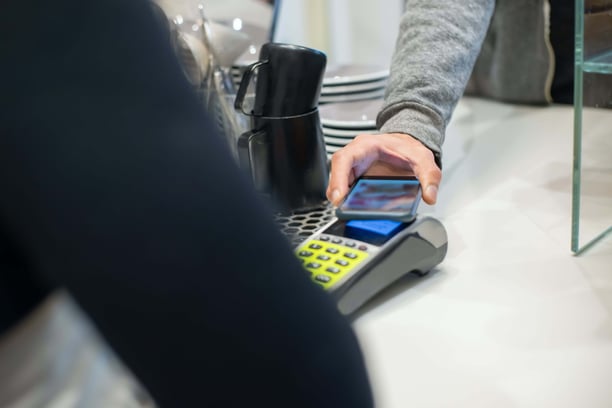Ask consumers to describe their optimal payment experience, and they’ll likely report speed, security and convenience.
Text to pay, or paying through Short Message Service (SMS), satisfies these ideals. Simple, expedient and, with the right platform, safe, text to pay has understandably become an increasingly popular form of digital payment.
With mobile payment apps used by an estimated four out of five Americans, it seems that businesses would benefit from employing a variation on the trend with their own simplified and frictionless payment platform. But let’s put the obvious advantages of SMS payments aside for a moment.
Is pay-by-text a passing craze, or is it here to stay?
Table of Contents
- What is Text to Pay?
- How Does SMS Payment Work
- Advantages of Text to Pay
- Current usage and trends
- Challenges and limitations
- Comparing Text to Pay with other Payment Methods
- Best Practices for SMS Payments
What is Text to Pay?
Text to pay is a service used by businesses that allows customers to make payments by text messages. Customers typically click a link within a text message that directs them to a secure payment gateway. Then the customer will usually receive a confirmation message after the payment goes through. Many customers prefer to pay by text message, especially if they are more mobile-centric.
How Does SMS Payment Work?
The process of SMS payment is straightforward:
- Businesses text customers an invoice or payment prompt with the option of paying via a secure link
- Customers use the link to input their credit card details, pay with funds in their digital wallet (like Apple Pay) or use their card information on file
The pandemic ushered in the necessity of remote, contactless payments. Still, the appeal of mobile payment apps and peer-to-peer (P2P) payments like Venmo and text-to-pay has not only lingered but grown dramatically. The latest data demonstrates that 35% of small business consumers prefer to pay by text, while some experts anticipate that SMS payments will skyrocket in popularity in the coming years.
Advantages of Text to Pay
Roughly 68% of businesses use SMS to communicate with customers, whether for an appointment reminder or to promote a sale. Extending this to include a fast, streamlined way to pay via text may enhance your customers’ experience.
More specifically, text to pay boasts the following benefits:
- Convenience – 9 out of 10 consumers prefer to communicate with businesses via SMS instead of by phone. Pay by text meets this consumer demand while also furnishing customers with the ease of paying in two to three taps.
- Speed and Efficiency – Text to pay accepts payments in real-time, and is substantially faster than making a phone call, sending a check in the mail, or logging in online. Thus, it can improve cash flow for businesses. Plus, since text messages have a considerably higher open rate than emails, you probably won’t have to chase after your customers with payment reminders.
- Reduced Payment Errors – Text to pay allows customers to use their preferred payment methods, such as PayPal or Google Pay. This can help businesses avoid chargebacks due to card issues and help customers catch and fix payment errors more easily.
Current Usage and Trends
The latest statistics reveal that a mere 4% of small businesses offer the option to pay by text. This might be due to the relative newness of the practice, which may raise concerns about the security of SMS payments.
However, SMS payments may be less vulnerable to fraud: Customers must provide explicit consent to receive texts from a business, payment prompts are submitted from a verified number, and SMS payment providers use secure payment portals.
With all that said, SMS payments are on the rise in several industries, particularly:
- Real estate
- Restaurants
- Salons
- Businesses that offer subscription-based services
Adopters of SMS payments view pay by text as a practical progression of consumers using their smartphones to conduct everything from online shopping to making dinner reservations.
They also know that consumers want a range of payment options and a streamlined checkout experience—and that as many as 73% of consumers state they would cease doing business with a company if their checkout experience failed to meet their expectations.
Challenges and Limitations
As with all things related to technology, text to pay will only evolve and improve as time progresses. What challenges and limitations presently exist may be manageable with the right platform, insights and advantages, such as:
- Compliance – To implement text to pay, you must first comply with SMS guidelines, including obtaining express consent from your consumers and allowing them to opt out. The opt-in and opt-out process can be as simple as asking customers to text you an SMS keyword. Compliance is even easier when you have a reputable SMS marketing platform, like Textedly, to help you navigate the rules.
- Integration – There are several steps you’ll need to take to implement SMS payments, like selecting an SMS payment provider that offers Payment Card Industry (PCI) compliant, secure integration. Platforms such as Textedly serve as a one-stop shop for your SMS and MMS needs, including Text to Pay Services, which include helpful features like a seamless merchant setup and a broad view of incoming payments.
- Fees and Costs – Some forms of payment may be subject to a card-not-present rate, depending on the platform you use and the financial institutions you accept. Many businesses generally accept these fees because expanded payment options translate to a more diverse (and reliable) revenue stream.
Comparing Text to Pay with Other Payment Methods
Text to Pay vs. Mobile Payment Apps
When comparing text to pay with popular mobile payment apps like Venmo, Apple Pay, and Google Pay, the differences become quite apparent. Text to pay leverages SMS to facilitate transactions, offering a streamlined payment process directly through a simple text message. This method stands out by allowing businesses to reach customers without necessitating app downloads or complex setups. Customers receive a payment link via SMS, which they can click on to complete the transaction, making it an accessible option even for those who prefer not to use specific apps. In contrast, mobile payment apps often require users to download and maintain specific applications, which can be a barrier for some. While apps like Venmo, Apple Pay, and Google Pay provide robust features and integrations for managing payments and storing transaction histories, text to pay excels in its simplicity and ease of use, catering to a broader audience by minimizing technological hurdles and focusing on direct engagement.
Text to Pay vs. Traditional Payment Methods
When evaluating text to pay against traditional payment methods such as credit card payments over the phone, online payments, and mailed checks, the advantages of text to pay become strikingly clear. Text to pay offers a swift and seamless payment experience, bypassing the need for lengthy phone calls or complex online forms. Unlike credit card payments over the phone, which involve manually entering payment details and can be prone to human error, text to pay delivers a direct payment link via SMS, allowing customers to complete transactions with a simple tap.
Compared to online payments that may require navigating multiple web pages or logging into various accounts, text to pay simplifies the process into a single, easy-to-use text message. Additionally, unlike mailed checks that can be slow and cumbersome, text to pay processes transactions almost instantly, significantly speeding up cash flow and reducing administrative overhead. This modern approach not only enhances customer convenience but also streamlines operational efficiency, making it a compelling choice for businesses aiming to optimize their payment processes.
Best Practices for SMS Payments
Compliance and Security
When implementing SMS payments, adhering to best practices for compliance and security is crucial to maintaining trust and safeguarding sensitive information. Compliance with SMS regulations, such as those outlined by the Telephone Consumer Protection Act (TCPA) and various data protection laws, ensures that your messaging practices respect consumer consent and privacy. Additionally, integrating robust security measures is essential to protect against fraud and data breaches. This includes employing encryption protocols to secure payment data during transmission, utilizing secure authentication methods to verify users, and ensuring that your SMS platform complies with industry standards for payment processing. By prioritizing these practices, businesses not only mitigate risks but also foster customer confidence, creating a secure and reliable payment experience through SMS.
Customer Communication
Effective customer communication is vital for successful SMS payments, and adhering to best practices can significantly enhance the user experience. Start by personalizing payment requests to create a more engaging and relevant interaction; addressing customers by their names and tailoring messages to their specific needs helps build trust and ensures clarity. Additionally, provide clear and concise instructions within the SMS to guide customers through the payment process effortlessly. Include straightforward prompts such as "Click the link to securely complete your payment" and ensure the payment link is easily accessible. Avoid jargon and keep messages brief to prevent confusion. By focusing on personalized communication and clear instructions, you can streamline the payment experience, reduce errors, and foster positive customer interactions.
Monitoring and Optimization
Monitoring and optimization are crucial for maximizing the effectiveness of your text to pay process. By tracking performance metrics such as payment completion rates, response times, and customer engagement levels, you gain valuable insights into how well your SMS payment system is functioning. This data allows you to identify any bottlenecks or areas for improvement, ensuring that the payment experience remains smooth and efficient.
Equally important is gathering customer feedback, which provides firsthand information on their experiences and any challenges they may encounter. Regularly analyzing this feedback helps you refine and enhance the text to pay process, addressing concerns and adapting to evolving customer needs. By combining performance tracking with proactive feedback collection, you can continually optimize your SMS payment system, delivering a more seamless and satisfactory experience for your customers.
Harness the Future of Payments with Textedly
Mobile payments are predicted to become the go-to payment method for consumers. By 2028, the U.S. mobile payment market is expected to reach $11.83 billion. SMS payments stand to become a large segment of this, as it can be a win-win situation for businesses and consumers.
Text-to-Pay by Textedly can help you get in on the action. Our services enable you to submit payment reminders, streamline recurring payments and boost your cash flow, all through a secure system that safeguards your customers’ data.
Gain an edge over your competitors by scheduling a demo with us today.







.png)